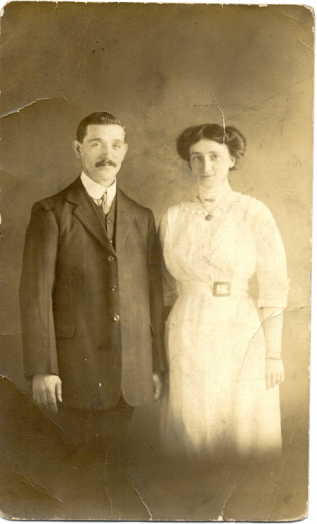Great War Dundee
This is Dundee's story of those that served in the First World War, and of the people left at home
David Galloway Paton
Military Information
- Date of enlistment: 11.10.1898
- Place of enlistment: Dundee
- Service no: 6553
- Rank: Private
- Service Occupation:
- Awards:
- Regiment/Service: Gordon Highlanders
- Unit/Ship: 1st Battalion
Personal Information
- Date of Birth: 21.04.1881
- Place of Birth: 39 North Church St, Dundee
- Address: 1822 William Ave, Winnipeg
- Occupation: Mill Worker, Customs & Excise Officer
- Mother:
Catherine Galloway
- Father:
George Neish Paton
- Siblings:
James, Elizabeth, Marion, Jane, Georgina, Catherine, Jessie & Isabella
- Spouse:
Mary McGuff
- Children:
Mary, David & George (Twins), Bruce &Catherine , born 11.12.1916 (Twins)
- Age at Death: 74
- Date of Death: 16.08.1955
- Place of Death: Kenora, Ontario, Canada
- Burial Country: Canada
- Cemetery: Brookwood Cemetery, Winnipeg
More about David Galloway Paton
David had served in the Boer War from 6th May 1901 to 21 Oct 1902 and received the South Africa Medal and clasps – Cape Colony, Orange Free State and Transvaal & S.A.
He was discharged at Perth on 10 Oct 1910.
On 15 Oct 1910 he re-enlisted. David emigrated to Canada in 1912 and was married there in the same year. It would appear that at the outbreak of war David, being a reservist was recalled to duty with the Gordon Highlanders. Following the Armistice David returned back to Canada.
David Galloway Paton enlisted with the Gordon Highlanders on October 11, 1898 at Dundee. The following day he was taken on the strength of the Gordons Depot at Aberdeen, where he most likely took his recruit training. Four months later he was posted to the 1st Battalion, Gordons, based at Edinburgh. DGP did not join his battalion for quite some time, though, as the 1st Gordons were in India, about to join the 2nd Gordons in South Africa. In May 1900, he was transferred to the army training centre at Aldershot. His file has few details about his time there. A year later he proceeded with a draft to South Africa aboard SS Crotava to finally join the battalion he had already been a part of for almost two years. Again, his file is very unclear. Much of what I found is based on his truly incredible Regimental Conduct Sheet and his Medical History forms. Regimental Conduct Sheets are not uncommon in the files I’ve researched, but they are usually a single page, rarely as many as two pages. DGP’s was SIX PAGES !!! And, part way through, he was awarded a Good Conduct stripe, (eventually he’d earn two.) For example, I know he was at Bloemfontein in the first week of June 1901 as there’s a charge noted. Oddly, this confirmed that he took part in the Orange Free State campaign. The 1st Gordons returned to the UK in September 1902, taking up home service duties after an absence of about 18 years. For his South Africa service, DGP received the Queen’s South Africa medal and three clasps, (awarded for service in SA between 1899 and 1901); and the King’s South Africa medal, (for SA service between 1901 and 1902). As far as I know, no clasps were awarded with the KSA.
The 1st Gordons spent about a year and a half at Glasgow before moving to Cork, Ireland in 1904. While in Cork, he applied to extend his service by one year, remaining at Cork. In the “It’s a Small World” category, DGP and my sister-in-law’s great-grandfather served together with the 1st Gordons between 1904 and 1906. In 1906, on completion of eight years’ active service, he was transferred to the A List Reserve, based at Perth. Some sources say Aberdeen. I’m assuming the A Reserve was not active duty, given that there were no further notations on his Regimental Conduct sheet. His full service expired on October 10, 1910, and three days later he volunteered for the D List Reserve. From previous research I found that there was some attraction to volunteering for the D List. For a term of five years, the reservist was expected to keep himself in good shape. A small stipend was paid each month
He also had to be willing to return to the army if called up before his D List time expired, and it is this obligation that answers your questions. In March, 1912, DGP immigrated to Winnipeg while still on the D List. He found work with the Canadian Pacific Railway Weston Shops which, if I remember correctly, was also where William Harvey worked. Soon after arriving, he married Mary McGuff at St Thomas Anglican Church. Members of the Paton Family were active in this parish for many years. Their first daughter, Mary, was born the following August. When war was declared, the D List Reserve was called up, including reservists who lived abroad. DGP probably received a telegramme on or about August 05, 1914, directing him to report in. Several reservists were called up, (including many for the Belgian and French Armies) here. A special CPR train was laid on, which departed from Winnipeg on August 17, 1914. The CPR station has been repurposed since, but still stands at 181 Higgins Avenue, if you want to check it on Google.
By mid-September, DGP had reported to the Gordons Depot at Aberdeen. Soon after he was posted to the 2nd Battalion, then concentrating at Lyndhurst. (The 2nd Gordons returning to the UK from Egypt.) Almost immediately after landing in Zeebrugge, the 2nd Gordons went into the front lines near Ypres, Belgium. Within a month, he was wounded, but not severely. He spent a brief time convalescing, but was back with his regiment by November 22. It was during this time that the regular British Army was almost wiped out. The story goes that Kaiser Bill referred to them as “a contemptible little army” and he would walk right over them. Well, they didn’t, the survivors from the Fall of 1914 forever after referring to themselves as the “Old Contemptibles” DGP’s obituary noted that he was a member of the Old Contemptibles Association.
Your last question was, “how does he appear on the 1916 Canadian Census, when he was on active duty in France”. The answer is that, as a D List reservist, his service obligation only extended to the end of his five year term. Unlike most volunteers and conscripts, DGP did not sign on for “the duration of the war”. When the end of his term neared, he was transferred to the Infantry Depot at Le Havre, and then on to the Gordons Depot at Aberdeen. DGP was discharged as time expired at Aberdeen on November 02, 1915. He shipped home in late November, arriving at Winnipeg on December 02. The 1916 Census was taken the following June.
Following the war he received a War Service Gratuity. I have no details on this, yet, as I have no way of getting access to the file. What is referred to as his service number 14243-D-17, is not. It’s a file number. In Canada, he was paid in Canadian funds. He would have received his medals sometime between 1921 – 1923. They would have been issued through the UK’s War Office and not from Canada. The 1914-15 Star was an exception. The ribbon for that was issued circa 1917 to anyone who was eligible. In addition, a special clasp with two roses was also available, but only by request. DGP requested them through the Perth Depot in 1920. The addition of the clasp changed his 1914-15 Star to a Mons Star, and marked him as an Old Contemptible. Sadly, over one hundred thousand of these claps were made, but almost none issued, as so few who were eligible actually survived to request it.
Research and additional images very kindly supplied by Jim Busby, Winnipeg, Canada.
Information and image kindly supplied by Irene Phillips, further information and images very kindly supplied by Jim Busby, Winnipeg, Canada.
Can you tell us more about David Galloway Paton'? Some additional facts, a small story handed down through the family or perhaps a picture or an heirloom you can share online. Contact our curator...

